Categories: Electric installation work
Number of views: 19819
Comments on the article: 2
Installation of open wiring in the home
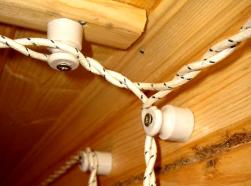 Among the types of laying electric wires inside residential premises, the method of their open location on building structures is the oldest, time-tested.
Among the types of laying electric wires inside residential premises, the method of their open location on building structures is the oldest, time-tested.
Technically, this laying method can be carried out:
1. stationary fixing of wires;
2. temporary placement of portable cables - extension cords.
Carrying is a backup method for short-term connection of individual electrical appliances. Constantly using them is not recommended. The currents of the loads completely pass through them, and the entire structure is subjected to periodic mechanical stress that can cause damage. Extension cables with portable cables require frequent inspections.
Open wiring has three characteristic features at once:
1. Visible to any visitor and therefore should be performed beautifully, attractively;
2. is exposed to sunlight, which can eventually destroy the layer of insulation unstable to it;
3. less than other types protected from accidental mechanical stress.
Existing modern methods of open wiring take into account all these three factors, allow you to create an exclusive design of rooms in the retro style, which many owners of private houses, cottages and cottages love, and give them a different look.
This method is especially suitable for elite wooden buildings made of logs or glued beams, when it is necessary to preserve the integrity of the wall structure and show their decorative texture.
It is also used for additional installation of conductive lines in the case when the room has already been completed with finishing work, a unique interior has been created, which should be preserved.
Types of stationary open wiring
Fastening wires to the building elements of the building is carried out by various methods. Practical application in our time received five ways:
1. cable laying with brackets;
2. retro style on casters from porcelain RSh-4;
3. plastic ducts;
4. corrugated metal hose with plastic corrugation;
5. European skirting boards.
All plastic products for installation must be fire resistant, not support combustion.
Wall and ceiling cabling
In open wiring, it is allowed to use cables with light-resistant insulation, for example, grades APPV (with aluminum core) or PPV (copper). The cable with the marking VVGNG-LS is best suited for technical characteristics due to the fire-fighting properties of its insulation:
-
does not support combustion;
-
It has a reduced smoke emission.
Since overheating of the wiring may occur when the network is overloaded, the heat generated from it should not be transferred to building structures. When placing the cable on a wooden surface, an asbestos tape is laid under it and fastened in one of the ways:
-
metal brackets with gaskets to the base;
-
tin strips with buckles;
-
ribbon with buttons;
-
bandage strips;
-
plastic mounting clamps.
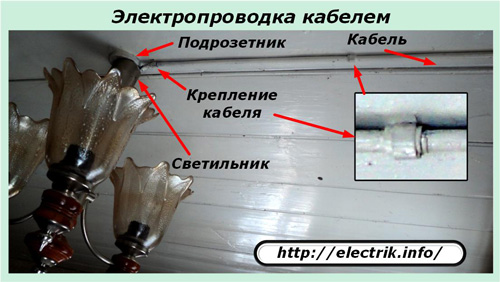
Cable laying in an open way inside residential premises is rarely used: it greatly complicates the creation of the original look of rooms, giving them a breech, office look. This method is better for technical rooms.
Switches, sockets and fixtures are mounted using sockets, which can have a decorative shape and color. They are impregnated with a special solution that provides fire-fighting properties.

Between the wall and the socket, a metal plate is also installed to prevent the spread of fire. This mandatory rule must be combined with the ideas of the designer.
Retro style wiring on casters made of porcelain RSh-4
Beautiful multi-wire flexible wires for these purposes are created with two layers of insulation. Its inner part provides protection against voltage potential, and the outer one, made of silk sheathing, is impregnated with a layer of varnish and reliably protects the inside from the action of solar radiation.
The total cross section of the core is selected according to the current load, but usually 2.5 mm2 is used.
The wires are held on rollers by means of a twist with uniform pitch and tension, are separated from the building structure with a sufficient air gap, which is visually controlled.
Read more about this open wiring method here: Retro wiring in a wooden house

Wiring in plastic cable ducts
The electric cable and wires are laid in an open way and, at the same time, are hidden from the eyes of a person decorative boxeswhich are selected by color and size.
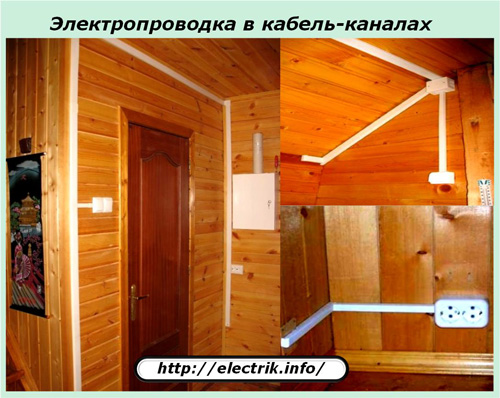
The cable channel can be mounted on the wall with self-tapping screws or simply glued. In the second case, it is necessary to pay attention to the preparation of a smooth and even plane for installing the box.
When installing it in this way, first glue the back of the cable channel with glue and press it to the marking place to transfer part of the glue there. Then the box is immediately removed from the wall for several minutes, waiting for the adhesive sides to harden. After that - tightly pressed for fast, reliable bonding.
When fixing the box in drywall, a butterfly dowel is used. At the joints of the components and in the places of their turns, additional devices are used: plugs, corners, adapters, connectors. They should easily dock and close gaps visible to the eye.
Wiring in decorative metal pipes
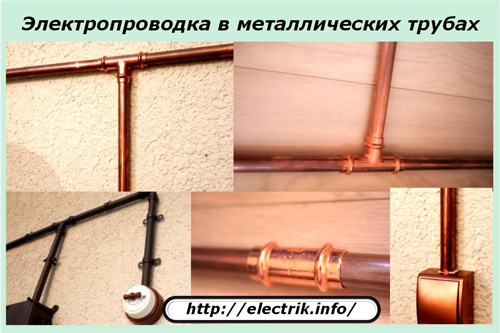
Initially, this method was created for the operation of electrical systems inside technical rooms with an increased risk of fire or explosion. The wires and their connections were completely placed in a sealed enclosure created by pipes of alloys of steel, aluminum or copper.
Such wiring is most protected from environmental influences and is separated from it. Pipes of standard length are assembled in the trunk due to couplings and adapters, turns are created smoothly by special angles of 90 degrees.
When assembling, welding is not applied, all work is performed with a hand tool. The technology allows you to change the network configuration, if necessary, without much labor.
The use of decorative coatings for copper and brass pipes made it possible to use this method for laying open electrical wiring in everyday life, to create a beautiful design that emphasizes the antiquity in combination with bronze and copper lamps.
Corrugation wiring
This method of open wiring is considered one of the easiest. It is common, popular, but it is better suited to the outside of electrical networks located on building surfaces outside residential premises. The appearance of the corrugation is difficult to combine with the design of living rooms.
The corrugation is well suited for attics, basements, garages: those places where you need to quickly lay wires, protecting them with an additional plastic case. Selecting the diameter of the corrugation, you can create a trunk to accommodate several parallel cables in one pipe.
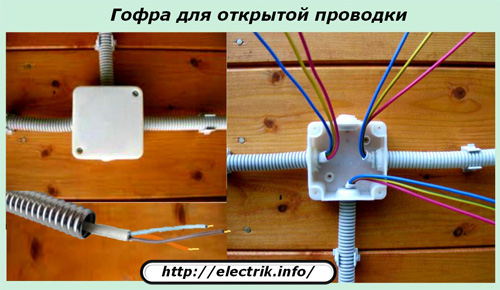
Another feature of this method is the need to pass the prepared cable or wires through it before fixing the corrugations on the wall, which presents certain difficulties.
To do this, use an intermediate element - a cable or wire, which is introduced into the tube from the corrugation in advance. Then one end of it is fixed, tied to some support or holding pliers, and the other is attached to the cable or wires inserted into the corrugations. To facilitate installation, they must be pressed tightly to create a reserve of space between their surface and the corrugation.
The wire is held up and the wires are carefully inserted into the corrugation.
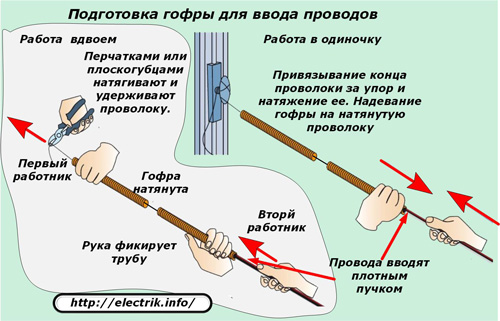
Wiring in decorative skirting boards

The use of floor or ceiling skirting allows you to hide, mask traces of electrical wiring and at the same time conveniently place it in prepared decorative gutters.
Electrical models of skirting boards differ from construction by the presence of a cavity to accommodate cable or wires. Corners, joints and bends are closed with special plugs, fitted in shape. The overall color of the design is chosen according to the taste of the owner.
When installing such a skirting board, the frame is first attached to the wall along its perimeter, and then the wiring is laid in it and closed with decorative covers.
Installation steps
Choosing the type of open wiring, suitable for living conditions and meeting the size of the budget, you can engage in installation. It is better to divide it into six stages:
1. creating a room plan with the designation of wiring elements on it;
2. preparation of points for connecting lamps, sockets and switches;
3. placement of cables and wires;
4. cutting the ends and their commutation;
5. checking the installation by removing the electrical characteristics of the circuit;
6. inclusion in a permanent job.
The sequence of these steps has been tested by numerous experiments. Violating it does not make sense.
1. Planning and marking the route
Creating even a simple sketch of a room on a notebook sheet with affixing sizes facilitates the marking process, allows you to fix possible errors on paper before starting work. This provides not only material savings, but also the time required to fix the alterations.
Planning work with tracing electrical wiring routes on paper, as a rule, eliminates the remounting of work already performed erroneously.
2. Installation of connection points for sockets, switches, lamps
From this point it is convenient to begin practical work on the building elements of the building. Under switches, lamps and sockets located on flammable wooden surfaces, it is necessary to install a metal base that does not transmit fire.
It should be located between the switchgear housing and the tree.

3. Laying cables and wires
Their installation is carried out along horizontal or vertical lines between previously installed connection points through junction boxes, if they are provided for by the project.
When it becomes necessary to pass wires through a wooden wall, floor or ceiling, a hole is drilled in this place and a metal pipe is installed - a sleeve that separates the wiring from the wood. Its edges should extend beyond the tree by 1 cm. They must be closed on both sides with plastic sleeves that protect the cable from mechanical cuts when pulled.
The number of cores in the cable must match the wiring diagram by TN-C-S or TN-S systems. After pulling the cable, its excess is cut off. The length of the cores for convenient cutting should protrude from the connection points by 10 ÷ 15 cm.
4. Cutting ends and connecting
It is better to carry out electrical work with a specialized electrician tool, configured to remove a certain length of insulation without damaging the metal conductive conductors.
The technology for connecting wires to sockets and switches for open and closed wiring is almost the same. It is described in detail in the article. "Features of the installation of sockets and switches".
5. Verification of installation and measurement of electrical characteristics
This important stage must be carried out not independently, but with the involvement of specialists from the electrotechnical laboratory, who check the quality of the circuit installation not only visually, but also by performing electrical measurements and tests, which can provide a guarantee of its performance.
During the checks, it is necessary to identify:
-
insulation resistance state of the electrical wiring in the assembled circuit;
-
load all power circuit breakers;
-
check leakage currents for installed RCDs and difluvomats;
-
evaluate the health of other specific elements of the circuit.
For all items of measurements taken, protocols will be issued to you with a conclusion on the suitability of the equipment for work. Only after that it is allowed to apply voltage to it.
6. Inclusion in work
Independent commissioning of equipment without testing and measuring it can lead to power outages, fires, electrical injuries. The prerequisites for their occurrence can be eliminated only by measuring the electrical characteristics of the network from extraneous sources.
Therefore, the first inclusion of a newly mounted open wiring should be trusted to specialists with the appropriate measuring, testing equipment, experience in its use.
See also at bgv.electricianexp.com
:
